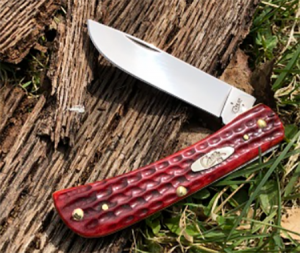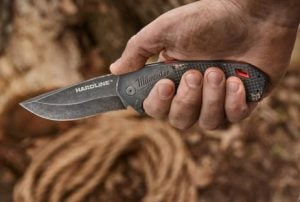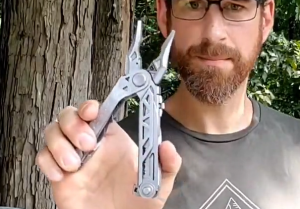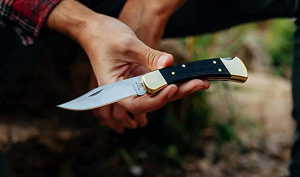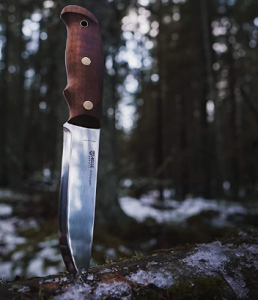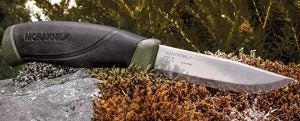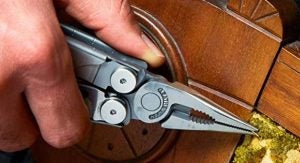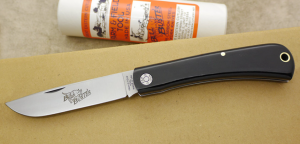No matter whether your farm is big or small, commercial or hobby, or focused on crops or livestock, there’s one tool that people in the agricultural industry universally carry: a knife. That trusty sharpened blade has a multitude of uses day-to-day, and it’s rare that you’ll ever see me without one on my hip. While we all have personal preferences about blade shape and choosing a fixed blade vs. a folding knife, it’s not uncommon to hear the question asked: Which are the best knives for farmers?
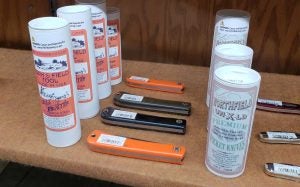
I’m a bit of a knife nut — I use them for farm chores, hiking, bushcrafting, tearing into Amazon deliveries, etc. So it was like heaven when I visited Smoky Mountain Knife Works. Located in Sevierville, Tennessee, SMKW is the largest knife store in the world, filling multiple stories with just about any blade you could imagine. It was a ton of fun and was cool getting to see so much up close and in-hand.
I spoke with one of the sales managers, and he walked me through some popular choices for farmers, as well as adding a couple of his own insights and suggestions. While this list isn’t exclusive to what SMKW recommended, many of the best blade choices on here come straight from their expertise and insights.
Check out these top picks of the best knives for farmers and ranchers, taking into consideration blade shape, metal, hardness/toughness, comfort, and safety:
Case Cutlery Sod Buster Folding Knife
The sod buster style of knife is that the folks at Smoky Mountain Knife Works kept coming back to time and time again as a great folding blade for farmers. The Sod Buster (and the smaller Sod Buster Jr.) is a traditional slip joint pocket knife that typically has one skinner blade and a simple handle with no bolster. The Sod Buster knife has many outdoor uses from cutting rope to shaving kindling or cutting flowers and vegetables. This knife is very versatile along with the thick handle that provides a comfortable fit and allows for a secure grip. They are also great because of their slim design and simple function — and the Case name is one that you can trust around the farm (there are lots of different colors to choose from). I’ll fess up, this is the knife I purchased when I left SMKW.
Milwaukee 3.5-inch Hardline Smooth Blade Knife
A hallmark of Milwaukee Tool’s products is their durability — bump, bash, drop, or douse them, they have a tendency to laugh in the face of abuse. The Hardline series of knives carries that quality with them. Built with D2 Tool Steel, incorporating a steel frame lock, and pivoting on a smooth-acting bearing system, Milwaukee Tool nailed the most sought-after traits for farmers. Plus the blades have a slim profile and feel comfortable in hand. There are four knives in Hardline series: three drop-point smooth blades between 2.5 and 3.5 inches and one 3-inch partially serrated tanto blade. Our preference is the smooth blades.
Gerber Center-Drive Plus Multi-Tool
One of the best offerings from Gerber Gear, the Center-Drive Plus stands out because when it launched in 2020, it was the first multi tool on the market to offer a 3.2 center axis driver that aligns like a screwdriver — you get all the leverage you can hope for on some of your harder tasks. We did an unboxing of this tool and have since spent a lot of time with it around the farm, and it truly is a handy item for a wide variety of tasks! The spring-loaded scissors, the partially serrated 3.25-inch blade, the large selection of bits, and the fact that most of the tool requires just one-handed operation means that it can be deployed in a flash, if necessary.
Buck Knives 110 Folding Hunter Knife
This knife is as famous as it is timeless. I know many a farmer who have carried 110s in their pockets for decades — there’s a lot of loyalty to the Buck name and to this blade. It’s a clip point, meaning that it can get into some spaces a chunkier blade can’t, and it’s easy to open with a nail notch on the blade. The lock back mechanism locks the blade open for reliable strength and safety. The only downside, depending on how an owner feels about steel types, is that the 420 is among the more basic kinds of steel. While much depends on the exact heat treatment, 420 is often seen as a steel that dulls fairly quickly but also easy to sharpen back up.
Helle GT Outdoor Hunting Knife
Don’t get sucked in by looks alone (though it does have a wonderfully intricate hand-carved handle), this Helle is one I’ve put to use a lot and absolutely love. The 9-inch drop-point blade carries over from the farm to the hiking path to the game trail with ease, making it a knife that’s hard to put down. Plus, the triple-layered laminated stainless steel on the blade will survive some of the less-than-ideal conditions that Mother Nature tosses at us.
Morakniv Companion Fixed Blade
Anyone who knows anything about knives can tell you that it’s hard to find a better value for your dollar than a Morakniv. The patterned, high-friction grip makes the knife comfortable to hold and easy to handle, and the 4.1 inches of carbon steel will take care of most of your toughest tasks. It’s such a simple blade, and, worst-case scenario, if it gets misplaced, it’s a lot easier to replace price-wise than any other knife on this list.
Leatherman Wave Multitool
It’s hard to make a knife list for farmers and leave off the game-changing brand in multitools: Leatherman. And out of everything they make, the Wave is our favorite (and the company’s most popular). It is equipped with 17 tools: knives, pliers, screwdrivers, a small bit driver for eyeglasses, wire cutters, a wire stripper, scissors, bottle and can openers, files, a saw, and a ruler. Pretty much perfect for the jack-of-all-trades that a farmer has to be.
Great Eastern Cutlery Farm Field and Tool #21 Bull Buster
Farm and Field Tool knives are designed strictly for those who want a tough and durable pocket tool. These knives feature an all steel construction and boast rugged delrin, acrylic, and micarta handles (I’m a sucker for a micarta handle). They are built with 1095 high carbon blades and springs, as well as reinforced pins for the most difficult of cutting tasks. They are also a 100 percent American made product.
NOTE: This knife, which was released in 2019, is out of stock at most places. We’re hoping that it’ll be restocked or reissued soon!
Honorable mentions:
- Spyderco Para-Military 2: On many lists about folding knives, this is at the top as it’s commonly considered just about the best everyday carry (EDC) blade on the market. But farm chores aren’t “normal” chores for most people. While this CPM S30V full flat-ground knife is an overall outstanding tool, it’s not as tailored to rural lifestyles like some of these others are. Plus, it’s pricier than most on this list.
- The Artisan Cutlery Ravine: When I visited SMKW, I just missed an orchard owner who bought eight of these knives for his farmhands to use in the field. With a thicker blade and D2 steel, this folder is a heartier knife than many others you’d come across.
- Bark River Bravo Squad Leader: Yes, this knife is gonna cost you some coin, but the craftsmanship of it is difficult to beat by other production fixed blades. There’s some weight in this knife, so you can tell that it’ll stand up to some hard tasks, plus it has a bowie-style blade that’s got universal applications.
What to look for in the best knives
While many people make decisions based on price, it’s functionality that should be the priority. And the functionality needs will be different for everyone. Perhaps you want a fixed blade for really hard jobs, which means you’ll need to be comfortable using a sheath. Perhaps you want a folder that can be opened with one hand for quick use. Perhaps you just need something really small for cutting tape or baling twine. Those kinds of needs will inform every knife-buying decision.
What to look for in knife steel
The two overarching qualities that people look at are hardness and toughness, which can sound very similar if you are unfamiliar with the blade terminology. Knives with good hardness will keep an edge really well but will also be more brittle than lower hardness knives, so they can chip a lot easier. Tough knives are usually made of a softer steel that isn’t brittle but does have to be sharpened more often, especially if used with more aggressive tasks (axes, for example, are often made with tougher steels). A blade can’t maximize both tough and hard at the same time, so you have to decide what balance works for you.
It’s also important to consider how corrosive a metal is and whether it has a coating on it to help repel rust and other hazards — thus extending the life of your farm knife. Blade HQ has some great guides for really diving in-depth into these qualities. Just remember, there’s no “best” knife steel out there, there’s only the best knife steel and blade for your needs.
This article was originally published May 22, 2019, and was updated September 28, 2021, and November 30, 2022.
